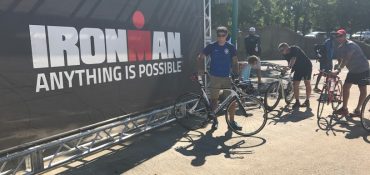Rachel Eberhard
March, 2013This week we learn more in the second installment of the Age Group training diaries from Rachel Eberhard. To swim, or not to swim, that is her question as she entertains us with her encounter with Masters Swimming.
MASTERS SWIMMING 101
The term “masters” is pretty intimidating. Master black belt. Master’s degree. The Master’s golf tournament. A single word that clearly draws a line as to who can and cannot qualify to hang with the best of the best. Which is why I was preparing myself to be the laughing stock of the pool at my first U.S. Masters Swimming workout.
Prior to plunging into my first real masters swim, my training consisted of me getting into a pool and going until my watch told me to stop. Pretty simple–and pretty damn boring. I grew up on a lake and was always a strong swimmer, although I never formally competed. So naturally my head started spinning when I heard, “6 x 200s descend on the 4:30, negative split, leaving on the top.” Whoa–MATH?!?! Lord knows that all numbers start to melt together the second I approach 80% of my maximum heart rate. Soon after, I was scolded for fiddling with my Timex. ”You won’t need that,” my coach said. He pointed to a round plastic clock, numbered 0 to 60, with only one hand. ”The clock is God. Just worry about what this one says.” After a quick debrief on swimmer-speak, I felt enlightened to learn that “leaving on the bottom” didn’t mean diving to the bottom of the pool and that “cruise pace” won’t expect you to swim like a shark is chasing you. It was also a relief to discover that the term “masters” simply means 18 and older.
My first workout wasn’t pretty. I started to think about my grocery list and lost count of my 6th repetition. Fatigue started to set in, and my feet started cramping up. For a solid hour, I kicked and exhaled like a maniac and felt like my shoulders needed oiling à la Tin Man. Yet, I felt awesome! Finally, my swim workouts had purpose and structure! I finally had a time for a 100–my very own benchmark! I started to understand how to use the clock to my advantage and look for evidence of improvement. I felt my endurance start to build over time as I developed my swimmer’s lungs. I was able to sprinkle in drills that broke up the hour, focusing on high elbows and torso rotation. It helped to have others sharing your lane and keeping pace–a constant reminder to keep going, don’t stop. It also became a silent challenge to stay in the swirl of bubbles from the person swimming ahead of you (chasing feet is good drafting practice)! My pool workouts got a masters makeover, and I was more mindful about how I was spending my time in the water with each passing second.
“The clock is God,” the coaches joked. And it never lies.
***More of Rachel’s training musings can be found at tritriagainblog.com***



